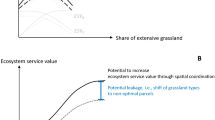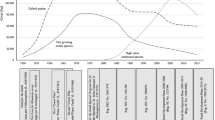Abstract
This work compares the net revenues of maintaining grasslands versus shrublands as part of the habitat of the Cervus elaphus big game species in Mediterranean agroforestry ecosystems. For this purpose, data published by the Regional Government of Andalusia (SW Spain) were used to analyze revenues and expenditures under two scenarios: an optimistic one and a pessimistic one. Revenue is generated from both the value of game trophies and the sale of meat. In the grasslands option, expenditure is associated with the need to supply supplemental food since, unlike shrublands, Mediterranean grasslands do not produce forage crops during the summer months. To analyze the expenditure of supplemental feeding, monthly market prices for corn grain in the province of Cordoba (this province covers an area of almost 1.4 million hectares) were obtained for the period 2015–2019. Our results show that, in net revenues terms, substituting shrublands for grasslands is not always the best option under the conditions analyzed.
Similar content being viewed by others
References
Abellán MD, Martínez JE, Palazón JA, Esteve MA, Calvo JF (2011) Efficiency of a protected-area network in a Mediterranean Region: a multispecies assessment with raptors. Environ Manag 47:983–991. https://doi.org/10.1007/s00267-011-9640-5
ASAJA (Asociación de Jóvenes Agricultores de Andalucía) (2015–2019) Boletines Mensuales provincia de Córdoba, Spain
Brand LA, George TL (2001) Response of passerine birds to forest edge in coast redwood forest fragments. Auk 118(3):678–686. https://doi.org/10.1093/auk/118.3.678
Brazaitis G, Roberge JM, Angelstam P, Marozas V, Pėtelis K (2005) Age-related effects of clear-cut–old forest edges on bird communities in Lithuania Scan. J For Res 20(6):59–67. https://doi.org/10.1080/14004080510040959
Caballero R (1985) Hábitat y alimentación del ciervo en ambiente mediterráneo ICONA Monografía 34 Madrid, Spain
Campos P, Ovando P, Mesa BM, Oviedo JL (2016) Environmental income of livestock grazing on privately owned silvopastoral farms in Andalusia, Spain. Land Degrad Dev 29(2):1–12. https://doi.org/10.1002/ldr.2529
Campos P, Oviedo JL, Álvarez A, Mesa B, Caparrós A (2019) The role of non-commercial intermediate services in the valuations of ecosystem services: application to cork oak farms in Andalusia, Spain. Ecosyst Serv 39:100996. https://doi.org/10.1016/j.ecoser.2019.100996
Charles JK, Ang BB (2010) Non-volant small mammal community responses to fragmentation of kerangas forests in Brunei Darussalam. Biodivers Conserv 19:543–561. https://doi.org/10.1007/s10531-009-9691-6
Costa JC (coord) (2006) Dehesas de Andalucía: caracterización ambiental. Consejería de Medio Ambiente, Junta de Andalucía, Sevilla, Spain
Cox MP, Dickman CR, Hunter J (2003) Effects of rainforest fragmentation on non- flying mammals of the Eastern Dorrigo Plateau, Australia. Biol Conserv 115:175–189
Díaz Gaona C, Rodríguez V, Sánchez M, Ruz JM, Hervás C, Mata C (2014) Estudio de los pastos en Andalucía y Castilla la Mancha y su aprovechamiento racional con ganado ecológico. Asociación Valor Ecológico-Ecovalia, Sevilla, Spain
Fernández-Olalla M, Muñoz-Igualada J, Martínez-Jaúregui M, Rodríguez-Vigal C, San Miguel-Ayanz A (2006) Selección de especies y efecto del ciervo (Cervus elaphus L.) sobre arbustedos y matorrales de los Montes de Toledo, España central Invest Agrar. Sist Recur For 15(3):329–338
Fischer J, Lindenmayer DB (2002) Small patches can be valuable for biodiversity conservation: two case studies on birds in southeastern Australia. Biol Conserv 106:129–136
González Redondo P (2010) La producción de carne de especies cinegéticas en Andalucía. In: Consejería de Agricultura y Pesca (ed) La producción de carne en Andalucía. Junta de Andalucía, Sevilla, Spain, pp 341–374
González LM, Oria J, Sánchez R, Margalida A, Aranda A, Prada L, Caldera J, Molina JI (2008) Status and habitat changes in the endangered Spanish Imperial Eagle Aquila adalberti population during 1974–2004: implications for its recovery. Bird Conserv Int 18:242–259. https://doi.org/10.1017/s0959270908000245
Guangzhi Y, Zhigang J, Zhilong Z, Bingfeng W, Yong W (2003) Feeding habitat of giant pandas (Ailuropoda melanoleuca): why do they prefer bamboo patch edges? J Zool Lond 261:307–312
Herruzo C, Martínez-Jaúregui M (2013) Trends in hunters, hunting grounds and big game harvest in Spain. For Syst 22(1):114–122. https://doi.org/10.5424/fs/2013221-03371
Herruzo C, Martínez-Jaúregui M, Carranza J, Campos P (2016) Commercial income and capital of hunting: an application to forest estates in Andalucía. For Pol Econ 69:53–61
Junta de Andalucía (2007) Orden de 13 de Julio de 2007 Consejería de Medio Ambiente. BOJA 169 Andalucía, Spain
Katona K, Gál-Bélteki A, Terhes A, Bartucz K, Szemethy L (2014) How important is supplementary feed in the winter diet of red deer? a test in Hungary. Wildl Biol 20(6):326–334. https://doi.org/10.2981/wlb.00053
Klein GP, Cameron N (2012) Effect of habitat gradients on space use by white-footed mice (Peromyscus leucopus). J Mammal 93(3):706–715. https://doi.org/10.1644/11-mamm-a-258.1
Lande US, Loe LE, Skjærli OJ, Meisingset EL, Mysterud A (2014) The effect of agricultural land use practice on habitat selection of red deer. Eur J Wildl Res 60:69–76
Lindemann ES, Harris JP, Keller GS (2015) Effects of vegetation, landscape composition, and edge habitat on small-mammal communities in Northern Massachusetts Northeast. Northeast Nat 22(2):287–298. https://doi.org/10.1656/045.022.0205
Menzel MA, Ford WM, Laerm J, Krishon D (1999) Forest to wildlife opening: habitat gradient analysis among small mammals in the southern Appalachians. For Ecol Manag 114:227–232
Palomares F, Delibes M, Ferreras P, Fedriani JM, Calzada J, Revilla E (2000) Iberian Lynx in a fragmented landscape: predispersal, dispersal, and postdispersal habitats. Conserv Biol 14(3):809–818
Pasalodos-Tato M, Ruiz-Peinado R, Del Río M, Montero G (2015) Shrub biomass accumulation and growth rate models to quantify carbon stocks and fluxes for the Mediterranean region. Eur J For Res 134(3):537–553
Pérez-González J, Barbosa AM, Carranza J, Torres-Porras J (2010) Relative effect of food supplementation and natural resources on female red deer distribution in a Mediterranean ecosystem. J Wildl Manage 74(8):1701–1717
Putman RJ, Staines BW (2004) Supplementary winter feeding of wild red deer Cervus elaphus in Europe and North America: justifications, feeding practice and effectiveness. Mammal Rev 34(4):285–306
Sáenz de Buruaga M, Carranza J (2009) Gestión cinegética en los ecosistemas mediterráneos. Consejería de Medio Ambiente Junta de Andalucía, Sevilla
Schaefer JA, Morellet N, Pépin D, Verheyden H (2008) The spatial scale of habitat selection by red deer. Can J Zool 86(12):1337–1345. https://doi.org/10.1139/Z08-122
Shaw JH (1985) Introduction to wildlife management. McGraw-Hill, New York
Toenies MJ, Miller DAW, Marshall MR, Stauffer GE (2018) Shifts in vegetation and avian community structure following the decline of a foundational forest species, the eastern hemlock. Condor 120(3):489–506. https://doi.org/10.1650/condor-17-204.1
Torres-Porras J, Carranza J (2017) El ciervo y otros ungulados. UcoPress, Universidad de Córdoba
Vetter D, Rücker G, Storch I (2013) A meta-analysis of tropical forest edge effects on bird nest predation risk: edge effects in avian nest predation. Biol Conserv 159:382–395. https://doi.org/10.1016/j.biocon.2012.12.023
Acknowledgements
The authors wish to thank two anonymous reviewers for their comments and suggestions that have improved the manuscript.
Author information
Authors and Affiliations
Corresponding author
Additional information
Publisher's Note
Springer Nature remains neutral with regard to jurisdictional claims in published maps and institutional affiliations.
Rights and permissions
About this article
Cite this article
Zamora, R., Segado, G., Fernández-Salguero, P. et al. Grassland versus Shrubland habitat and game management in Mediterranean ecosystems: an application for the Cervus elaphus species. Agroforest Syst 95, 85–91 (2021). https://doi.org/10.1007/s10457-020-00563-w
Received:
Accepted:
Published:
Issue Date:
DOI: https://doi.org/10.1007/s10457-020-00563-w




